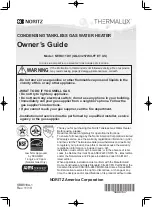
25
Venting
General
Flue Exhaust Tee
An optional Flue Exhaust Tee is available to facilitate
horizontal venting. Any reference to horizontal venting
that exits the back of the heater requires this tee. Refer
to Table J for the appropriate kit for your model.
A
CAUTION:
Proper installation of flue venting
is critical for the safe and efficient operation of
the heater.
Table J: Flue Exhaust Tee Kits
Model
Diameter
Order Number
399B–499B
6”
011839
649B, 749B,
899B
8”
011840
989B
10”
011841
1259B, 1529B
12”
011842
1799B, 1999B,
2069B
14”
011843
2339B
16”
011844
Category IV
– A heater which operates with a pos-
itive vent pressure and with a vent gas temperature
that may cause excessive condensate production in
the vent.
See
Table K
for appliance category requirements.
Support of Vent Stack
The weight of the vent stack or chimney must not rest
on the heater vent connection. Support must be pro-
vided in compliance with applicable codes. The vent
should also be installed to maintain proper clearances
from combustible materials.
Barometric Damper
A barometric damper may be required when vent
heights exceed 25 feet or when the draft is greater
than -0.08 in. WC. In these installations, a barometric
damper (single or double acting) is recommended.
The damper should be installed NO CLOSER than 18
in. from the discharge of the unit and no closer than
18 in. from a combustible ceiling. The damper can be
installed in horizontal or vertical runs of vent pipe as
necessary. Installation in a bull-head tee is acceptable
as shown in the NFGC.
The weights on the damper should be adjusted per
the damper manufacturer’s instructions for proper
operation.
Appliance Categories
Heaters are divided into four categories based on the
pressure produced in the exhaust and the likelihood of
condensate production in the vent.
Category I
– A heater which operates with a non-pos-
itive vent static pressure and with a vent gas tempera-
ture that avoids excessive condensate production in
the vent.
Category II
– A heater which operates with a non-pos-
itive vent static pressure and with a vent gas tempera-
ture that may cause excessive condensate production
in the vent.
Category III
– A heater which operates with a positive
vent pressure and with a vent gas temperature that
avoids excessive condensate production in the vent.
NOTE:
For additional information on appliance
categorization, see appropriate ANSI Z21
Standard and the NFGC (U.S.), or B149 (Canada),
or applicable provisions of local building codes.
A
CAUTION:
When condensate traps are
installed, condensate must be routed to an
appropriate container for neutralization before
disposal, as required by local codes.
A
WARNING:
Contact the manufacturer of the
vent material if there is any question about the
appliance categorization and suitability of a vent
material for application on a Category III or IV
vent system. Using improper venting materials
can result in personal injury, death or property
damage.
NOTE:
During winter months check the vent cap
and make sure no blockage occurs from build-up
of snow or ice.
Summary of Contents for Raypak Delta Limited 399B
Page 39: ...39 Wiring Diagram Models 399B 1259B...
Page 40: ...40 Wiring Diagram Models 1529B 2339B...
Page 51: ...51 DIAGNOSTIC DETAIL 12 J 7 J 6 J 5 J 3 0 2 0 16 S 1 F 2 F 3 F 4 F BLOWER DETAIL...
Page 53: ...53 13 J 8 J 10 J 11 J 4 J 2 J 3 J 6 C 14 J 9 J 1 J CONTROL BOX DETAILS...
Page 57: ...57 ILLUSTRATED PARTS LIST MODELS 989B 2339B 10 J 3 O 5 O...
Page 58: ...58 12 H 6 H 7 H 8 H 2 H 9 H 3 H 5 H 1 H 4 H 1 P HEAT EXCHANGER DETAILS BURNER ASSEMBLY DETAILS...
Page 59: ...59 CONTROL BOX DETAILS 9 J 8 J 23 S 13 J 10 J 3 O 10 J 3 O 5 O FRONT SWITCH DETAILS...
Page 66: ...66...
Page 67: ...67 Raypak Inc 2151 Eastman Avenue Oxnard CA 93030 805 278 5300 Litho in U S A NOTES...
















































